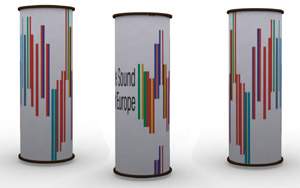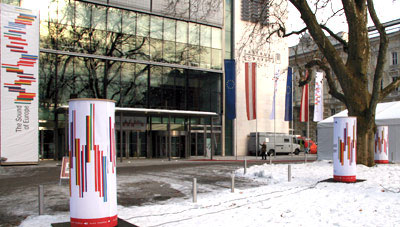Salzburg, 27.-28. Jan 2006
Mediatizing the Conference's Main Hall
Interactive media installations
| European Soundscape | |
| Europe is Real | |
| Europe: A Landscape of Ideas | |
| Leading
Opinions |
| Threshold to the Kingdom | |
| 27. Januar 1945 | |
| This is your Victory | |
| Faces of Europe | |
| Strength and Opportunities | |
| Europe all Weather | |
| Ars Electronica Futurelab |
"European Soundscapes"
Composed and compiled from the sounds, voices and music of European diversityby Rupert Huber.

The sound installation will be set up a few days in advance in the park adjacent to the Congress Center as a harbinger of the conference that will be getting passersby in the mood for the big event.

One of the values that we Europeans have in common is the appreciation of beauty.
This concept is multicultural and multimedial, but it means the same
in all the arts and modes of perception. Not everything can be expressed
in the music of beauty, but that is a part of the beauty and greatness
of art.
Just imagine the sound installation as oratorio; the various different
sounds become groups of instruments, if one considers the way they originated.
For instance, there is a piano, environmental sounds from all over Europe
and acoustic works of art by artists from all over Europe. These acoustic
artworks came about in so-called telematic real-time compositions—i.e.
the artists were linked up with each other via digital networks and could,
in this way, exchange sounds and then process them further. The voices—likewise
from all over Europe—are like singers, actors delivering a dramatic reading
and the chorus of a drama, all playing a tonally determinative role.
It is meant for the visitor approaching the Congress Center to experience
an illuminating sound projection domain upon which tonality rains down
like rays of sunshine on a January morning, and this as a way to do justice
to the idea of a united Europe.
A small acoustamatic serenade featuring Karl Böhm during a fictional
rehearsal of “Cosi fan tutte” will be presented to mark Mozart’s birthday.
It alludes to the fact that, in the spatial composition of the sound installation,
the distribution of the instrument groups corresponds to the first 25
measures of the Jupiter Symphony—a structural homage to Mozart.
A Musical Journey through Europe
Due to the special nature of the spatial setting—noise from the street and plaza as transitional zone to the nearby park—I give precedence to organic sounds like voices, bells and piano. Flat, two-dimensional expanses are contrasted by percussive elements. As in the Jupiter Symphony, in which the orchestra’s defined instrument groups do not produce the sounds alone but rather the way the instruments are spatially positioned (the physical seating arrangement of the musicians) also plays a role, the following instruments come into play:
Choral recording made throughout Europe
Sounds from telematic compositions (Horizontal Radio/Ars Electronica 1995, Radiotopia /Ars Electronica 2002, private exile/Wiener Festwochen 2004)Sounds recorded in almost all Europe countries
Original sound recordings made in Rome, Paris, Berlin
The spatial arrangement proceeds on the basis of five different loudspeaker positions (instrument groups). As in the classical literature—similar to a quintet—there are different models for the positioning of the speakers: e.g. all simultaneously play two or three voices, accompany one “melody voice,” polyphony (different interrelated sequences)
Rupert Huber, January 2006www.ruperthuber.com